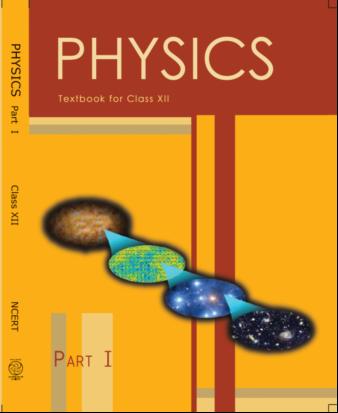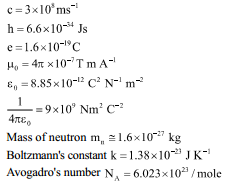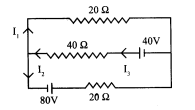
myCBSEguide App
Download the app to get CBSE Sample Papers 2023-24, NCERT Solutions (Revised), Most Important Questions, Previous Year Question Bank, Mock Tests, and Detailed Notes.
Install NowCBSE Question Paper 2007 class 12 Physics conducted by Central Board of Secondary Education, New Delhi in the month of March 2007. CBSE previous year question papers with solution are available in myCBSEguide mobile app and cbse guide website. The Best CBSE App for students and teachers is myCBSEguide which provides complete study material and practice papers to cbse schools in India and abroad.
Question Paper 2007 class 12 Physics

Class 12 Physics chapters wise list
- Electric Charges and Fields
- Electrostatic Potential and Capacitance
- Current Electricity
- Moving Charges and Magnetism
- Magnetism and Matter
- Electromagnetic Induction
- Alternating Current
- Electromagnetic Waves
- Ray Optics and Optical Instruments
- Wave Optics
- Dual Nature of Radiation and Matter
- Atoms
- Nuclei
- Semiconductor Electronic: Material, Devices and Simple Circuits
- Communication Systems
CBSE Question Paper 2007 Class 12 Physics
General Instructions:
- All questions are compulsory.
- There is no overall choice. However, an internal choice has been provided in one question of two marks, one question of three marks and all three questions of five marks. You have to attempt only one of the choice in such questions.
- Question numbers 1 to 5 are very short answer type questions, carrying one mark each.
- Question numbers 6 to 12 are short answer type questions, carrying two marks each.
- Question numbers 13 to 24 are also short answer type questions, carrying three marks each.
- Questions numbers 25 to 27 are long answer type questions, carrying five marks each.
- Use of calculators is not permitted. However, you may use log tables, if necessary.
- You may use the following values of physical constants wherever necessary:

1. An electron, an alpha-particle and a proton have the same kinetic energy. Which one of these particles has the largest de-Broglie wavelength?
2. Why should the material used for making permanent magnets have high coercivity?
3. The radioactive isotope D decays according to the sequence 
If the mass number and atomic number of D2 are 176 and 71 respectively, what is (i) the mass number (ii) atomic number of D?
4. What will be the values of input A and B for the Boolean expression?
5. Why is frequency modulation preferred over amplitude modulation for transmission of music?
6. The output of an OR gate is connected to both the inputs of a NAND gate. Draw the logic circuit of this combination of gates and write its truth table.
7. Draw a plot of potential energy of a pair of nucleons as a function of their separation. What is the significance of negative potential energy in the graph drawn?
8. A convex lens of refractive index 1.5 has a focal length of 18 cm in air. Calculate the change in its focal length when it is immersed in water of refractive index  .
.
9. Distinguish between the terms ‘average value’ and ‘rms value’ of an alternating current. The instantaneous current from an a.c. source is I = 5 sin (314 t) ampere. What are the average and rms values of the current?
10. Write the relation for the force acting on a charge carrier q moving with a Velocity
acting on a charge carrier q moving with a Velocity  through a magnetic field
through a magnetic field  in vector notation. Using this relation. deduce the conditions under which this force will be (i) maximum (ii) minimum.
in vector notation. Using this relation. deduce the conditions under which this force will be (i) maximum (ii) minimum.
11. A cylindrical metallic wire is stretched to increase its length by 5%. Calculate the percentage change in its resistance.
12. The electric field E due to a point charge at any point near it is defined as  where q is the test charge and F is the force acting on it. What is the physical significance of
where q is the test charge and F is the force acting on it. What is the physical significance of  in this expression ? Draw the electric field lines of a point charge Q whe n (i) Q > 0 and (ii) Q < 0.
in this expression ? Draw the electric field lines of a point charge Q whe n (i) Q > 0 and (ii) Q < 0.
OR
Define electric flux. Write its S.I. units. A spherical rubber balloon carries a charge that is uniformly distributed over its surface. As the balloon is blown up and increases in size, how does the total electric flux coming out of the surface change? Give reason.
13. Deduce an expression for the electric potential due to an electric dipole at any point on its axis. Mention one contrasting feature of electric potential of a dipole at a point as compared to that due to a single charge.
14. A parallel plate capacitor, each with plate area A and separation d, is charged to a potential difference V. The battery used to charge it is then disconnected. A dielectric slab of thickness d and dielectric constant K is now placed between the plates. What change, if any, will take place in
(i) charge on the plates
(ii) electric field intensity between the plates
(iii) capacitance of the capacitor.
Justify your answer in each case.
15. State Kirchhoff’s rules of current distribution in an electrical network. Using these rules determine the value of the current in the electric circuit given below.
16. Write the mathematical relation for the resistivity of a material in terms of relaxation time, number density and mass and charge of charge carriers in it. Explain, using this relation, why the resistivity of a metal increases and that of a semi-conductor decreases with rise in temperature.
17. Explain with the help of a labelled diagram the underlying principle and working of a step-up transformer. Why cannot such a device be used to step-up d.c. voltage?
OR
Draw a labelled diagram of an a.c. generator. Explain briefly its principle and working.
18. Given below are two electric circuits A and B
Calculate the ratio of power factor of the circuit B to the power factor of circuit A.
19. Define the term ‘resolving power’ of an astronomical telescope. How does it get affected on
(i) increasing the aperture of the objective lens?
(ii) increasing the wavelength of the light used?
Justify your answer in each case.
20. Write any four characteristics of electromagnetic waves. Give two uses each of
(i) Radio-waves (ii) Micro-waves.
21. In a plot of photoelectric current versus anode potential, how does
(i) the saturation current vary with anode potential for incident radiations of different frequencies but same intensity?
(ii) the stopping potential vary for incident radiations of different intensities but same frequency?
(iii) photoelectric current vary for different intensities but same frequency of incident radiations?
Justify your answer in each case.
22. Calculate the amount of energy released during the α-decay of

Is this decay spontaneous? Give reason.
23. What is a digital signal? Explain the function of modem in data communication. Write two advantages of digital communication.
24. Explain, with the help of a schematic diagram, the principle and working of a Light Emitting Diode. What criterion is kept in mind while choosing the semiconductor material for such a device ? Write any two advantages of Light Emitting Diode over conventional incandescent lamps.
25. Draw a labelled diagram of a moving coil galvanometer. State the principle on which it works.
Deduce an expression for the torque acting on a rectangular current carrying loop kept in a uniform magnetic field. Write two factors on which the current sensitivity of a moving coil galvanometer depend.
OR
State Biot-Savart law. Use it to derive an expression for the magnetic field at the centre of a circular loop of radius R carrying a steady current I. Sketch the magnetic field lines for such a current carrying loop.
26. What are coherent sources? Why are coherent sources required to produce interference of light ? Give an example of interference of light in everyday life.
In Young’s double slit experiment, the two slits are 0.03 cm apart and the screen is placed at a distance of 1.5 m away from the slits. The distance between the central bright fringe and fourth bright fringe is 1 cm. Calculate the wavelength of light used.
OR
State the condition under which the phenomenon of diffraction of light takes place. Derive an expression for the width of the central maximum due to diffraction of light at a single slit.
A slit of width ‘a’ is illuminated by a monochromatic light of wavelength 700 nm at normal incidence. Calculate the value of ‘a’ for position of
(i) first minimum at an angle of diffraction of 30°.
(ii) first maximum at an angle of diffraction of 30°.
27. State the principle of working of p-n diode as a rectifier. Explain, with the help of a circuit diagram, the use of p-n diode as a full wave rectifier. Draw a sketch of the input and output waveforms.
OR
Draw the symbolic representation of a (i) p-n-p, (ii) n-p-n transistor. Why is the base region of transistor thin and lightly doped? With proper circuit diagram, show the biasing of a p-n-p transistor in common base configuration. Explain the movement of charge carriers through different parts of the transistor in such a configuration and show that .
.
These are questions only. To view and download complete question paper with solution install myCBSEguide App from google play store or login to our student dashboard.
Last Year Question Paper Class 12 Physics 2007
Download class 12 Physics question paper with solution from best CBSE App the myCBSEguide. CBSE class 12 Physics question paper 2007 in PDF format with solution will help you to understand the latest question paper pattern and marking scheme of the CBSE board examination. You will get to know the difficulty level of the question paper.
Previous Year Question Paper for class 12 in PDF
CBSE question papers 2018, 2017, 2016, 2015, 2014, 2013, 2012, 2011, 2010, 209, 2008, 2007, 2006, 2005 and so on for all the subjects are available under this download link. Practicing real question paper certainly helps students to get confidence and improve performance in weak areas.
- Physics
- Chemistry
- Mathematics
- Biology
- Accountancy
- Business Studies
- Economics
- History
- Geography
- Political Science
- Physical Education
- Computer Science
- Informatics Practices
- English Core
- Hindi Core
- Hindi Elective
- Other Subjects
To download CBSE Question Paper class 12 Accountancy, Chemistry, Physics, History, Political Science, Economics, Geography, Computer Science, Home Science, Accountancy, Business Studies and Home Science; do check myCBSEguide app or website. myCBSEguide provides sample papers with solution, test papers for chapter-wise practice, NCERT solutions, NCERT Exemplar solutions, quick revision notes for ready reference, CBSE guess papers and CBSE important question papers. Sample Paper all are made available through the best app for CBSE students and myCBSEguide website.

Test Generator
Create question paper PDF and online tests with your own name & logo in minutes.
Create Now
myCBSEguide
Question Bank, Mock Tests, Exam Papers, NCERT Solutions, Sample Papers, Notes
Install Now

